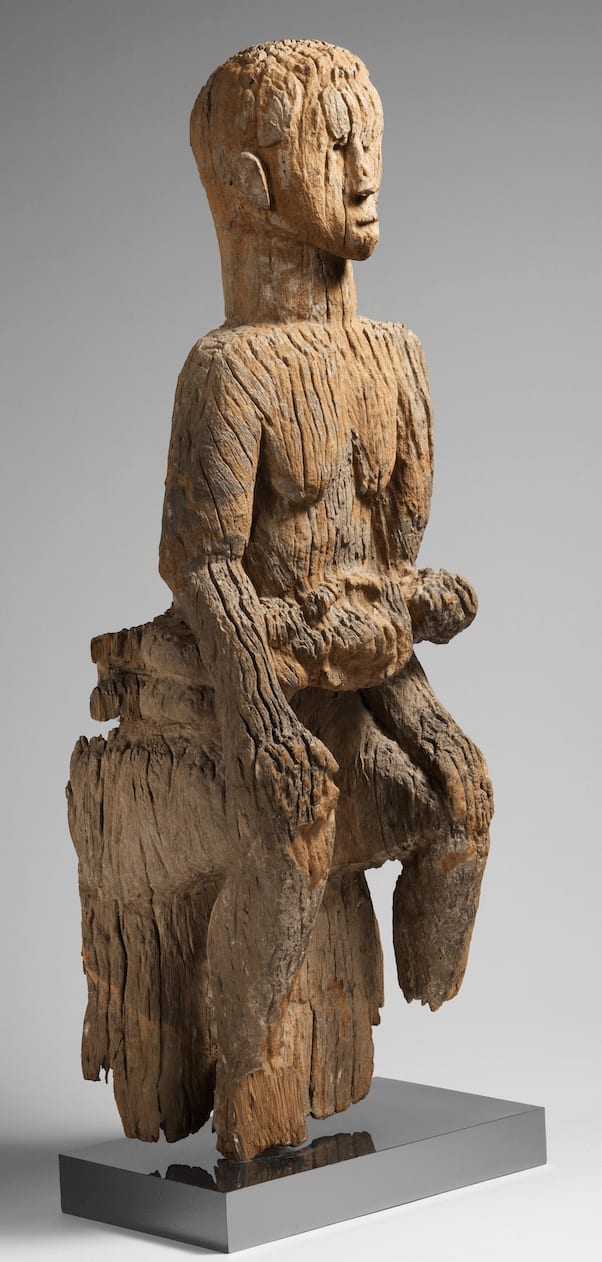
The upcoming exhibition Warriors and Mothers: Epic Mbembe Art will present 17 Mbembe figures at the Metropolitan Museum of Art and runs from December 9, 2014 to September 7, 2015. The exhibition is organized by Alisa LaGamma and Yaëlle Biro and will focus on the two most frequent themes of this type of sculpture: mothers nurturing their offspring and male warriors – originally these figures were sitting at the end of large communal drums.
The catalyst for this exhibition is the above mother and child figure, acquired by the Metropolitan Museum in 2010 (info). In December 2009, this maternity figure was unsuccessfully offered for sale by Christie’s Paris (estimated € 500,000 – 700,000). It was later bought through Christie’s from its Japanese consignor, Hiroshi Ogawa, who himself had acquired it from Hélène Kamer (now Leloup) in 1974. It was Kamer who introduced the art world to Mbembe sculpture that same year with her landmark exhibition Ancêtres M’Bembe. The eleven figures of monumental stature featured in that inaugural show presented an at that time completely unknown sculptural tradition to connoisseurs of African art. The catalogue of this exhibition remains the sole monograph on the subject. Dispersed internationally among private and institutional collections, these works will be reunited in New York for the first time since 1974.
There will be no exhibition catalogue, but last year Alisa LaGamma wrote an excellent article on the subject, called Silenced Mbembe Muses in the Metropolitan Museum Journal – which is freely available here. It contains a very interesting chapter on the these objects’ discovery:
The international recognition of Mbembe sculpture resulted from field collecting by the African dealer named O. Traoré in dialogue with the eye and instincts of Hélène Kamer. Already established internationally as a leading dealer in African art, Kamer had undertaken extensive collecting on the ground in Mali, Guinea, and Ivory Coast earlier in her career. She recalls that during the 1970s West Africans regularly traveled to Paris with works that they had imported into France, and active collectors and dealers perused them in the hotel rooms of the sixth arrondissement that the Africans used as their base of operation. Through these channels, an influx of artifacts from the Nigerian-Cameroonian border region commenced, as a result of two phenomena: European art dealers were not traveling to this area because of the Biafran War, and Malians engaged in the art trade during the 1950s and 1960s, having exhausted sources for material closer to home, had continued to seek out artifacts far ther and farther east. Kamer first became aware of Mbembe sculpture on September 29, 1972, when she encountered Traoré, a dealer from an established Malian family, at the hotel where he was staying on the rue de l’Ancienne Comédie. Among the works she saw that afternoon, a massive statue from Nigeria with broken arms immediately caught her attention. In acquiring that work, Kamer inquired about its origins. In order to protect his source, Traoré declined to discuss specifics of where it had been collected but promised to return with other examples as well as information on their use, significance, and subject matter, which he would gather from an elder on his next visit to the region. From his base in lomé, Togo, close to the Nigerian border, Traoré made two further forays to obtain additional works for Kamer. He returned to Paris from the first trip on February 6, 1973. At that time he provided the provenance of the works he brought with him, relating them to a small group known as the Mbembe, located east of the town of Abakaliki in the former Anambra State in the Cross River region. By the time these objects were collected by Traoré, they had long become a relic of past practices in the community that commissioned it several centuries earlier.
